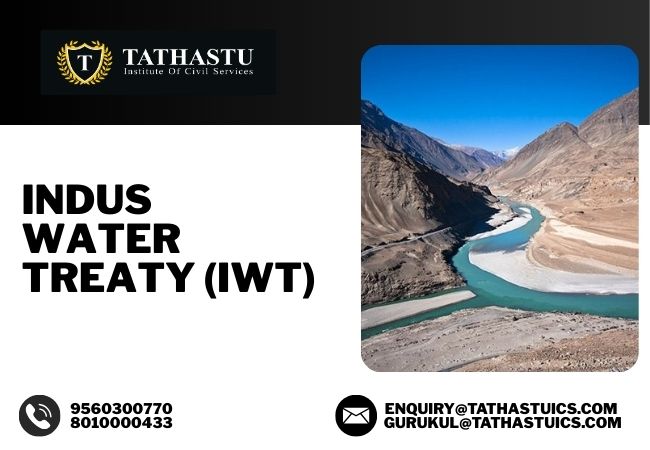The Indus Water Treaty (IWT), signed in 1960, is a landmark river water sharing agreement between India and Pakistan, that aimed at resolving disputes over the waters of the Indus River system.
What is Indus Water Treaty?
- The Indus Water Treaty was signed on September 19, 1960, facilitated by the World Bank as a mediator.
- It sets forth the guidelines for sharing the waters of the six rivers in the Indus River basin – the Indus, Jhelum, Chenab, Ravi, Beas, and Sutlej – between India and Pakistan.
- The treaty details the rights to usage, mechanisms for resolving disputes, and cooperative measures for the peaceful management of these transboundary water resources.
Key Provisions of Indus Water Treaty
- Water Allocation– The treaty designates the three Western rivers—Indus, Jhelum, and Chenab—for unrestricted use by Pakistan, while India is granted unrestricted use of the three Eastern rivers—Ravi, Beas, and Sutlej.
- This division results in Pakistan receiving about 80% of the total water resources, leaving India with 20%.
- Permanent Indus Commission– A Permanent Indus Commission has been established by both nations, comprising commissioners from each side who are tasked with holding annual meetings and facilitating ongoing communication regarding the management and utilization of river waters.
- Dispute Resolution Mechanism:
The treaty includes a three-tiered dispute resolution process:- Permanent Indus Commission for addressing questions.
- Referral to a Neutral Expert (appointed by the World Bank) for unresolved technical differences.
- A Court of Arbitration for legal adjudication if disputes persist.
- Water Use Restrictions for India on Western Rivers– India has restrictions on water use for the Western rivers, allowing for non-consumptive activities such as limited irrigation, domestic purposes, flood control, navigation, and hydroelectric power generation, all of which must comply with specific design and operational regulations.
Historical Context of Indus Water Treaty
- The partition of India in 1947 left Pakistan as the lower riparian country, dependent on waters flowing from Indian territory.
- Initial disputes over canal waters led to the creation of the treaty, which was facilitated by the World Bank to prevent conflict.
- The IWT has remained the only water-sharing treaty in Asia even after multiple wars and tensions, helping maintain cooperation over one of the most critical shared natural resources in the region.
Timeline of Indus Water Treaty
- 1960: The treaty was signed and put into effect.
- 2013: India received a favourable ruling from the Permanent Court of Arbitration regarding the Kishanganga hydroelectric project on the Jhelum River, permitting operations with specific conditions.
- 2016-2019: In response to terror incidents such as Uri and Pulwama, India halted meetings of the Indus Commission and stressed the complete exercise of its water rights.
- 2022-2023: Escalating disputes led to the appointment of a Neutral Expert and India’s demands for a revision of the treaty, pointing to climate change and Pakistan’s resistance.
- 2025: Following the Pahalgam terrorist attack, India suspended the treaty, significantly altering the treaty’s framework.
Recent Developments after Pahalgam Attack
- In April 2025, following a terror attack in Pahalgam, India halted its commitments under the Indus Waters Treaty (IWT).
- This move provides India with increased authority over the Western rivers, allowing for improved hydropower production, flood management, and water storage without oversight from Pakistan.
- Pakistan, which depends significantly on the Indus system for its agricultural and urban water needs, confronts serious challenges, including risks to food security and economic stability.
Disputes & Challenges of Indus Water Treaty
India’s Concerns
- The treaty disproportionately benefits Pakistan, granting it 80% of the water resources.
- Pakistan’s ongoing objections to India’s hydroelectric initiatives on the Western rivers hinder India’s progress.
- The treaty is outdated and does not include clauses to tackle the effects of climate change.
- Indian states in the Indus basin suffer economic repercussions due to restricted water usage rights.
Pakistan’s Concerns
- There are apprehensions about diminished downstream water flow resulting from Indian infrastructure projects.
- Claims of “water terrorism” have been directed at India.
- There is a call to ensure the maintenance of environmental flow requirements.
- Options for legal action are limited if India decides to unilaterally suspend or terminate the treaty.
Implications of Suspension of Indus Water Treaty
For India
- Enhanced control over water resources.
- Ability to grow hydroelectric power initiatives and water storage facilities.
- Possible decline in data exchange and oversight, impacting transparency.
- Greater influence in bilateral relations related to national security.
For Pakistan
- Threats to farming, city water supply, and the livelihoods of rural communities.
- Possible financial damages and heightened susceptibility to water shortages.
- Risk to national security and stability.
The Indus Water Treaty stands out as a unique symbol of collaboration in a tumultuous relationship between India and Pakistan. Nonetheless, shifting geopolitical factors, environmental issues, and security challenges have put its durability to the test. India’s recent suspension signifies the emergence of new strategic priorities, yet the treaty’s continued existence hinges on a balanced strategy that guarantees sustainable and fair water distribution while maintaining regional peace and security.

